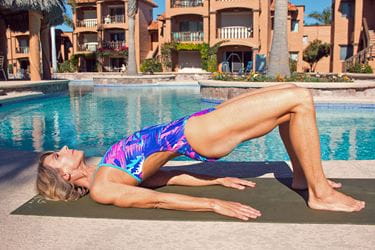Three Yoga Poses for Better Posture
Proper posture can help you swim faster and experience less pain
Swimmers and computer users often have hunched shoulders and upper backs, a protraction of the shoulder girdle that impairs proper movement and function of the muscles, tendons, and ligaments around the shoulder. Yoga postures, or asanas, can improve posture and body alignment both in and out of the water. Optimal posture facilitates better breathing, freer shoulder movement, and reduced potential for impingement or repetitive injury. This can mean better swimming times and less pain.
Breath, or pranayama, is the most vital component of yoga and should always lead the way when moving into and sustaining poses. Breathe long and slow and smooth, feeling expansion in your abdomen, rib cage, and chest. Notice the subtleties of your breath. Taking deep breaths will help you become more aware of the quality of your breath and how proper alignment enables you to take longer, more restorative breaths.
The Bridge, the Bow, and the Tree poses work in different ways to benefit postural alignment in swimmers. For best results, perform these asanas after aerobic activities because your muscles will be warm and more flexible.
Avoid the “no pain, no gain” approach. It’s fine to feel muscles activating and working, but you shouldn’t feel pain in your spine or joints. Move into a comfortable expression of the pose and remain there for five to 10 slow breaths.
Bridge (Setu Bandha Sarvangasana)
Benefits
The Bridge pose benefits swimmers in multiple ways.
First, it teaches swimmers how to adopt a level pelvis and neutral spine through core, gluteal, and hamstring muscle activation, which facilitates better alignment while swimming and doing other activities. Many people arch their backs during movement, which creates drag in the water and causes compression and may lead to pain in the lumbar spine.
Secondly, this pose creates expansion and stretching of the pectoral muscles in the chest as well as the front of the shoulder. This brings balance back to your posture, creating more space for unrestricted movement of muscles, ligaments, and tendons in the shoulder girdle while swimming or performing other upper body movements. The Bridge pose is considered a cooling pose in that it helps to relax the nervous system. It can be done at the end of a yoga practice or before bed (possibly followed by a meditation) to help you relax for a more restful night’s sleep.
How to Execute
Lie on your back with your arms alongside your body, palms down. Bend your knees and place your feet flat on the mat, hip-width apart. Ensure your head is level and your neck unrestricted. Position your knees directly over your ankles. Tuck your pelvis and slowly lift your hips up off of the mat until you feel a stretch across the front of the pelvis and thighs. Base the height of your Bridge pose on how your body feels as you raise your hips. There should be no discomfort in the neck (cervical spine) or other parts of the spine. Your glutes should activate in pair with your hamstrings. Don’t hold your breath. Keep your knees tracking over your toes. To open your chest and stretch your pectoral muscles more, clasp your hands underneath your butt, squeeze your shoulder blades together, and slowly inch the outside of the backs of your shoulders inward. Avoid this posture or proceed with caution if you have active or past neck injuries.
Bow (Dhanurasana)
Benefits
The Bow pose strengthens the back muscles (particularly the rhomboids) and rotator cuff muscles. This asana lengthens the front of your shoulders, chest, abdominal muscles, and quadriceps. By stretching the commonly shortened muscles in the front of your shoulders and pectorals, you’ll reduce the protraction of your shoulder girdle and have freer movement.
How to Execute
Begin lying on your belly and extend your arms out in front, palms down and parallel to the floor, and draw your elbows in until your arms are bent at about a 90-degree angle (cactus arms). Gently squeeze your shoulder blades inward and then lift your lower legs, head, chest, and upper ribs. Bend your knees and draw your heels toward your head until your ankles are stacked over your knees. You can stay with this position or progress if you don’t feel back discomfort. Reach your hands back toward your ankles and slowly grip them from the outside. Aim to keep your feet and ankles touching. Slowly raise your legs and torso up off the mat, without overly compressing your lower vertebrae. Gaze slightly upward. You will feel a frontal body stretch from your throat to thighs. Be cautious with this pose if you have a history of spinal problems. Any spinal discomfort is a signal to regress to an easier version of the pose.
Tree (Vrksasana)
Benefits

Balance comes into play each time you step up on the blocks. The Tree pose gives you the opportunity to practice balancing on one leg while maintaining optimal posture. In addition to engaging upper postural muscles, the deep, central, and lateral abdominal muscles work in partnership to help support your balance in the pose. The abdominal muscles play a key role in helping you balance and rotate while swimming. Focusing on your breathing and looking at something stationary at eye level makes balancing easier.
How to Execute
Stand on your mat or floor and shift your center of gravity slowly toward your left foot. Once you feel grounded with this weight shift, slowly raise your right foot, keeping your right leg bent and your knee turned out and place it on the inside of your calf or inner thigh of your left leg. If your balance feels shaky, you can start by perching your right foot on the floor instead. Avoid placing your foot on the inside of your knee because it can damage the knee joint. Place your hands together in front of your heart in Anjali Mudra (palms together) or raise your closed hands up over your head, which will bring you close to a streamline position. Keep your head level. Spread your chest open. Imagine yourself growing taller as you lift toward the sky from the crown of your head, lengthening your spine. Slowly lower your leg and transition to the other side.
Categories:
- Technique and Training
SIGN UP FOR UPDATES FROM USMS

















